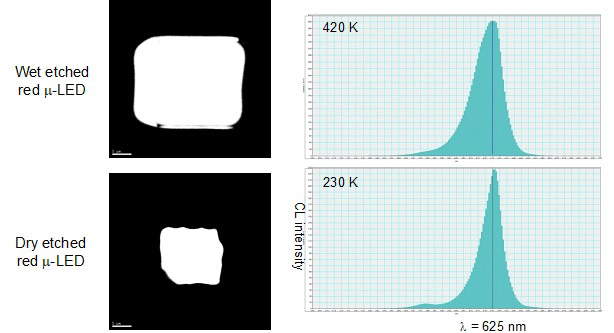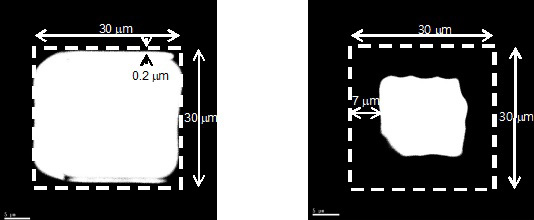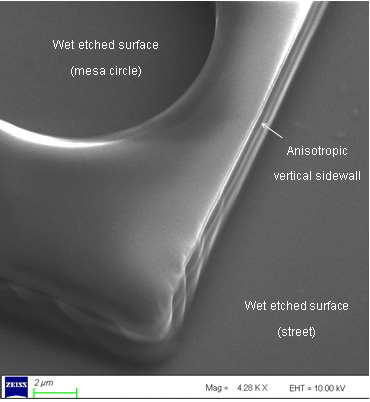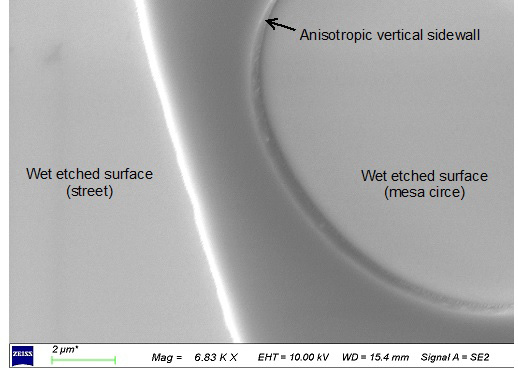News: LEDs
22 August 2024
Defect-free AlGaInP native red micro-LEDs by wet chemical etching
To realize true commercialization of the high-resolution micro-LED displays, reducing LED chip size without losing efficiency is one of the key challenges to be solved urgently, especially for the phosphide-base red micro-LED which – due to material characteristics – is more vulnerable to efficiency drop than blue and green as chip size shrinks.
The main reason for the micro-LED efficiency drop is the chip sidewall defects generated by energetic plasma during dry etching of the mesa. Nevertheless, there have been no reliable options to replace the dry etching up to now. As a result, most effort has been focused on post-dry etching recovery, such as chemical treatment, annealing, and passivation deposition. However, they are helpful for partial recovery only. More importantly, they are not effective for tiny chips used for high-resolution displays because sidewall defect penetration depth is close to or exceeding the micro-LED chip dimension.
As a result, ‘defect-free’ etching has been sought for a long time. While wet etching is promising as it is ‘defect-free’, its fatal disadvantage is the isotropic etching characteristic, which leads to detrimental undercut. For this reason, wet etching has been perceived to be not suitable to etch small chips like micro-LEDs.
Recently, however, Verticle Inc of San Francisco, CA, USA – which specializes in R&D and production of inorganic LEDs and related display technologies – has made a breakthrough in developing mesa etching of the aluminium gallium indium phosphide (AlGaInP) native red micro-LED by ‘defect-free’ wet chemical etching.
Comparing sidewall defect penetration depth and effective mesa area between wet- and dry-etched AlGaInP red micro-LEDs
Sidewall defects in the wet- and dry-etched AlGaInP red micro-LEDs are observed and compared using cathodoluminescence (CL). During CL operation, an electron beam bombards the micro-LED surface and produces electron–hole pairs. Radiative recombination takes place from the electron–hole pairs in the undamaged crystal, hence bright emission images can be obtained. In contrast, non-radiative recombination takes place in damaged crystal, hence yielding little or no luminescence from the damaged portion of the micro-LED.
CL emission images and spectra in Figure 1 show a clear difference between the wet- and dry-etched AlGaInP red micro-LEDs. CL emission from the wet-etched micro-LED is significantly brighter and more than three times bigger than that of the dry-etched micro-LED. In particular, the sidewall defect penetration depth of the dry-etched micro-LED is ~7μm, compared with almost zero or less than 0.2μm for the wet-etched micro-LED (Figure 2). Accordingly, the effective mesa area of the dry-etched red micro-LED is only 28% of the wet-etched LED. The CL results show that there are almost zero or a negligible number of defects in the wet-etched AlGaInP red micro-LED.

Figure 1. CL emission and spectra of the mesa etched 30μm x 30μm AlGaInP red micro-LEDs; wet versus dry etching.

Figure 2. Sidewall defect penetration depth of the 30μm x 30μm AlGaInP red micro-LEDs after mesa etching; wet (left) versus dry (right) etching.
These results indicate that there is a distinct difference in the etching mechanisms between wet and dry etching. Wet etching removes material by chemical reaction so no defects are formed, whereas dry etching physically removes material by energetic plasma that causes defect generation on the chip sidewall.
Surface morphology and etch profile of the mesa wet-etched red micro-LED
Figures 3 and 4 illustrate the etch profile of the AlGaInP red micro-LEDs after 1.4μm-deep mesa wet etching. Wet-etched surfaces either on the mesa circle or on the street are mirror-like smooth, indicating that they are ideal for forming metal contacts.
In particular, the chip sidewall is highly vertical and anisotropic, so no undercuts are observed. From the fact that the smallest feature size is ~3μm and that the chip sidewall is highly anisotropic and undercut-free, it would be possible to etch less than 10μm AlGaInP micro-LED chips.

Figure 3. Surface morphology and sidewall etch profile of the wet-etched AlGaInP red micro-LED.

Figure 4. Enlarged morphology and etch profile of the wet-etched AlGaInP red micro-LED.
Both defect-free and undercut-free etch profile results indicate that the Verticle’s wet-etching technology appears to be ready to be applied for the mass production of phosphide-based native red micro-LEDs.
Besides the performance enhancement, cost benefits are huge with wet etching. Unlike single-wafer processing in the case of dry etching (for wafer diameters over 6-inches), wet etching is capable of etching multiple large-diameter wafers in one batch, resulting in massively high throughput and hence extremely fast takt time. Furthermore, wet-etching capital investment is incomparably lower than that of dry etching as there is no need for multiple extra high-cost process tools, such as ICP RIE (inductively coupled plasma reactive-ion etch) and ALD (atomic layer deposition).
Verticle is ready to apply the developed wet-etching technology to mass production of AlGaInP red micro-LEDs in order to accelerate commercialization of the entire range of micro-LED displays, ranging from large-screen to near eye displays.
Verticle develops chemical dicing for low-cost, high-performance mini-LEDs









